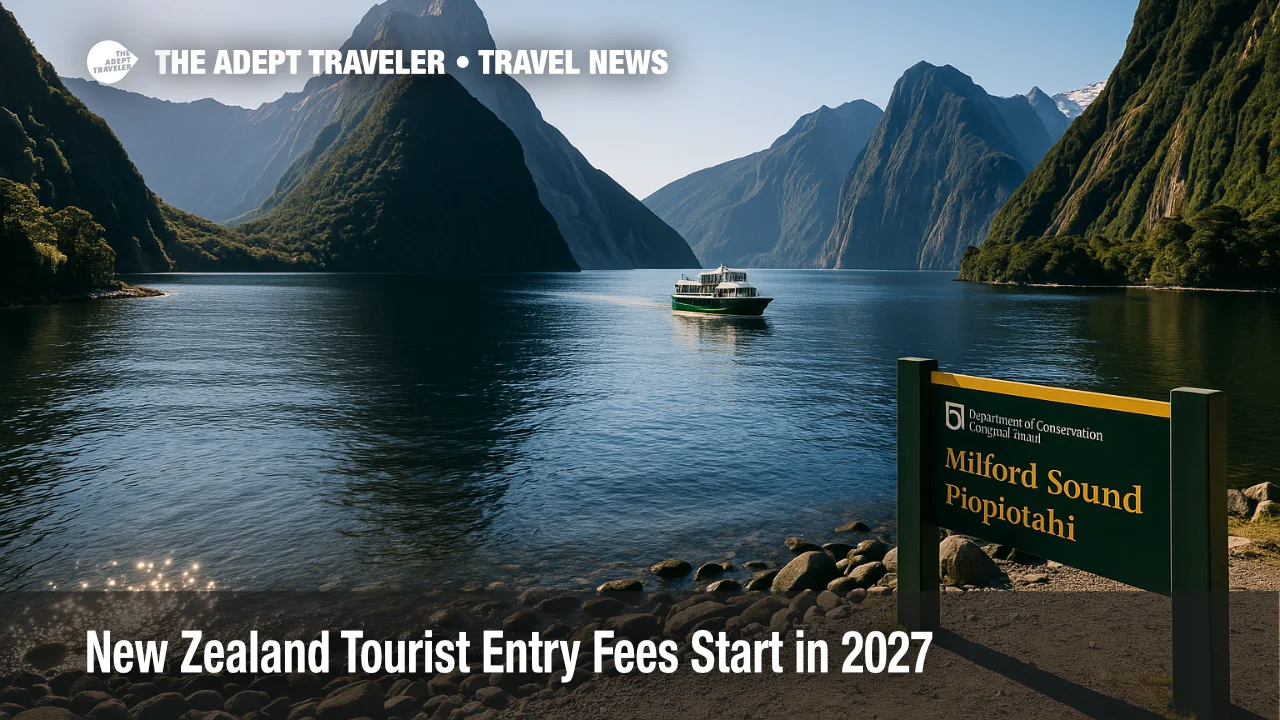New Zealand Tourist Entry Fees Start at Four Iconic Sites in 2027

New Zealand will soon ask overseas visitors to pay between NZ$20 and NZ$40 (NZD), about $12.00 to $24.00 (USD), to enter four of its most visited natural attractions, including Milford Sound and Aoraki Mount Cook. Wellington says the "modest" New Zealand tourist entry fees will funnel tens of millions into conservation while supporting higher-wage tourism jobs. Domestic visitors will still walk in for free. The plan forms part of a broader shake-up of conservation law that promises faster permits for business activity on public land and has already ignited fierce debate.
Key Points
- Why it matters: New Zealand tourist entry fees aim to raise NZ$62 million annually for conservation.
- Travel impact: Foreign visitors to Milford Sound, Aoraki Mount Cook, Cathedral Cove, and the Tongariro Crossing will pay from 2027.
- What's next: Parliament will draft fee rules and overhaul concession laws by late 2026.
Snapshot
Prime Minister Christopher Luxon unveiled the initiative alongside Conservation Minister Tama Potaka at the governing National Party conference. International tourists supply roughly 80 percent of foot traffic at the four pilot sites, yet currently pay nothing at the gate. Officials predict the scheme will generate up to NZ$62 million - about $38 million - every year, all ring fenced for trail upkeep, habitat restoration, and visitor facilities that underpin high-value tourism jobs. Kiwis will remain exempt because the landscapes are, in Luxon's words, "our collective inheritance." The government targets a 2027 start, giving agencies time to set up fee collection and resident ID systems.
Background
Tourism delivers 6.2 percent of New Zealand's GDP and directly employs 172,000 people. Visitor volume rebounded sharply after border controls lifted in 2022, reviving overcrowding concerns at headline sites such as Milford Sound and Cathedral Cove. Successive governments leaned on a nationwide visitor-levy model, but critics argued the NZ$35 International Visitor Conservation and Tourism Levy spread funds too thinly. The new, site-specific charges seek a tighter link between impact and investment, mirroring models in Bhutan and the Galápagos. Conservation groups broadly support user-pays funding but warn it must not replace core government budgets.
Latest Developments
How the Fee System Will Work
Ministers say foreign adults will pay a flat NZ$20-40 per visit, while children under 12 will be exempt. Digital ticketing, smartphone QR scans, and random ranger checks are on the table, reducing the need for physical booths in fragile areas. Revenue will flow into a fenced account monitored by Treasury, with public annual reporting. Officials estimate each dollar spent will return NZ$1.80 in avoided maintenance backlogs. A second-round review in 2029 could add Rotorua's Whakarewarewa Forest and the Abel Tasman Coast Track if targets are met.
Conservation Law Reforms Stir Debate
Alongside fees, Wellington will streamline concession approvals for tourism, grazing, renewable-energy, and telecom projects on conservation land, which covers one-third of the country. Luxon argues the current system is "totally broken," taking years for simple renewals and stifling rural jobs. Environmentalists counter that looser rules risk mining, logging, or resort sprawl in biodiversity hotspots. Forest & Bird labelled the overhaul "the most significant weakening of conservation law in a generation," warning it could open a pathway to land sales. Green Party co-leader Chlöe Swarbrick accused the government of putting profit before nature.
Analysis
User-pays conservation is hardly novel, yet New Zealand's approach is striking for its site-specific focus and explicit employment pitch. Channeling money directly back to the trails tourists tread strengthens the social licence for tourism and may ease pressure on taxpayers. However, the simultaneous push to loosen concession rules muddies the narrative. Combining eco-fees with easier commercial access risks perceptions of "pay-to-plunder," eroding the intended conservation brand. Success will hinge on transparency: annual audited statements, clear ecological indicators, and meaningful iwi (Māori tribal) partnership. If the government squares those circles, the model could become a blueprint for other overcrowded destinations. If not, it may fuel calls for stricter caps rather than higher fees. Either way, the move underscores how overtourism and fiscal gaps are forcing popular nature economies to rethink the bargain between visitor freedom and environmental stewardship.
Final Thoughts
From 2027 onward, anyone chasing Instagram-perfect shots of Milford Sound or Aoraki Mount Cook will pay a small premium. For most travelers, the cost will fade beside airfare and lodging, yet those New Zealand tourist entry fees could keep trails open, toilets clean, and endemic birds alive. The bigger question is whether parallel legal reforms tip the balance toward prosperity or pave a slippery slope toward over-commercialization. Watch the pilot sites closely; they may set the global playbook on reconciling conservation funding with mass tourism. Either way, the debate ensures the phrase "New Zealand tourist entry fees" will echo far beyond the Southern Alps.
